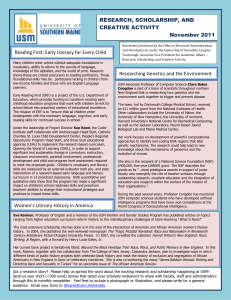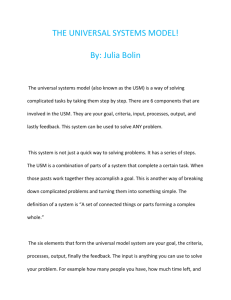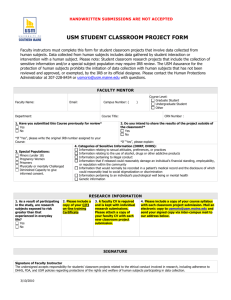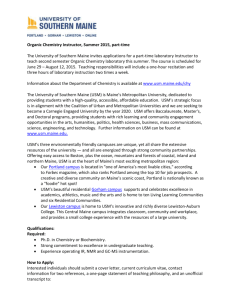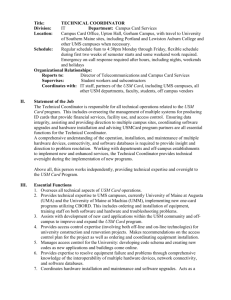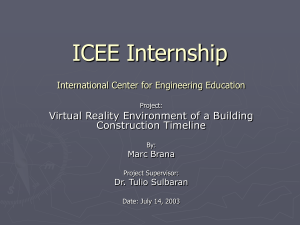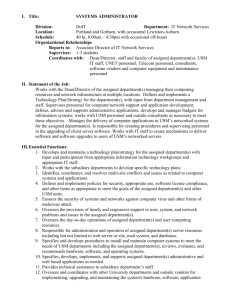USM Update - University of Maine System
advertisement
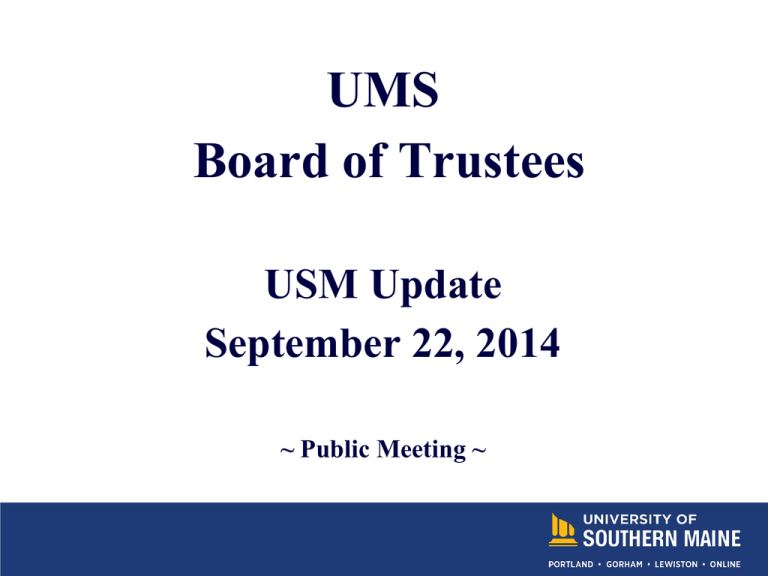
UMS Board of Trustees USM Update September 22, 2014 ~ Public Meeting ~ AGENDA 1. USM Goals and Objectives 2. Progress to date 3. The Challenge 4. Vision 5. Strategic Plan Elements 6. Four Immediate Priorities 7. Second Phase Plans 8. Implementation 9. Longer Term Issues 10. Attachments 2 USM GOALS AND OBJECTIVES • Operate with distinction • Budget for next year • Build for the future • Communicate 3 PROGRESS TO DATE 1. ASSEMBLED TEAM: • Martha Freeman, Joe McDonnell, Dick Campbell, Chris Quint, Tom Dunne, Cecile Aitchison, Jay Graves, Joyce Gibson, and Manuel Avalos • Reduced meeting time • Reduced cost 2. PRELIMINARY PLANNING: • Assess actual deficit • Operating plan outline • Academic reorganization outline • Set priorities • Retirement • Retrenchment • Recruiting and retention • Investments • Budget targets, approach to achievement 4 PROGRESS TO DATE continued 3. COMMUNICATIONS: • Kick-off breakfast with faculty and staff • Legislator meetings • Faculty Senate • Academic Leadership (Deans, Chairs) meeting • Student leaders • PPH op-eds • • • • • • David Flanagan: Off Campus: USM late in responding to changing world David Flanagan & Joe McDonnell: Off Campus: USM will survive and prosper by becoming a ‘metropolitan’ university Manuel Avalos: Off Campus: Let USM’s mission always be the transformative power of education Business Corporate Partners Mayors 5 THE CHALLENGE USM BUSINESS MODEL IS IRREPARABLY BROKEN 1. If no change, USM fails key indices of future viability: 2010 2015 • Declining enrollment (and shrinking applicant pool) 7,051 6,040 • Flat or declining net (tuition) revenue $143.4M $125.7M • Expenses increase faster than revenue $138.7M $132.7M • Declining in philanthropy (gifts, pledges, in-kind) $ 2.63M $ 1.9MFY14 • Increased competition from community colleges, private 7,010 7,157 FY13 colleges in the area and proprietary schools like Kaplan • Retaining students (First-time, first-year) 66% 6 67% THE CHALLENGE continued 2. Reasons are well rehearsed (understood) • Demographics • Competition and cost • State funding • Ambiguous value proposition and brand • Inflexibility, lack of innovation/growth • 2010 Non-traditional instruction 754 courses S,S,F • 2013-14 Non-traditional instruction 825 courses S,S,F 3. Current projections of deficit for FY16 7 THE CHALLENGE – Demographics Projected number of high school graduates: Maine 2012-20 © December 2012. Knocking at the College Door. Western Interstate Commission for Higher Education 8 THE CHALLENGE – Competition and Cost Comparison of Net Price Among Competitors $35,000.00 $30,000.00 USM USM USM $25,000.00 $20,000.00 $15,000.00 $10,000.00 $5,000.00 $2010-11 Net Price 2011-12 Net Price 2012-13 Net Price Central Maine Community College Southern Maine Community College University of Maine University of Southern Maine Plymouth State University Keene State College Husson Thomas College University of New Hampshire-Main Campus Saint Joseph's College of Maine Southern New Hampshire University University of New England 9 THE CHALLENGE – State funding State Appropriation Base Budget – University of Southern Maine Includes MEIF - Excludes one-time appropriation 48,000,000 47,000,000 46,975,074 46,000,000 45,000,000 44,286,316 44,378,391 44,610,156 44,000,000 44,198,306 44,035,848 43,766,456 43,000,000 42,000,000 FY09 FY10 FY11 FY12 FY13 FY14 FY 15 State Appropriation Base Budget – University of Maine System Includes MEIF - Excludes one-time appropriation 202,000,000 200,000,000 200,764,206 198,000,000 195,765,506 196,000,000 194,000,000 193,665,388 192,000,000 193,695,388 193,429,798 193,429,798 194,197,748 190,000,000 188,000,000 FY09 FY10 FY11 * The FY 2012 state appropriation increase to the University of Maine System was distributed by the Board of Trustees to support strategic initiatives. FY12 10 FY13 FY14 FY 15 THE CHALLENGE – Result 3. Current projections of deficit for FY16 11 USM VISION To turn around USM’s fortunes, we need: 1. A credible value proposition • • Measure against the best, e.g. U.S. News & World Report criteria for “Great School, Great Prices,” and Regional Universities A differentiated brand identity 2. A new vision • Metropolitan University • Focused • Aligned • Relevant to, and learning, from community • Student-centric • • • • • • Schedule Credits Technology High touch level of advising First year experience Entrepreneurial/Adaptive • • • • Cost center based (McGladrey) R & D expectations New curriculum model Incentivized collaboration within USM, among UMS campuses 12 USM VISION U. S. News & World Report: Maine College’s Now Ranked Rankings are based on several key measures of quality. Scores for each are weighted as shown to arrive at a final overall score. For regional universities and colleges, the assessment figure represents input from academic peers. The Scoring Breakdown Graduation and Retention Rates Assessment of Excellence Faculty Resources Student Selectivity Financial Resources Graduation Rate Performance* Alumni Giving * difference between actual and predicted Great Schools, Great Prices The calculation takes into account a school’s academic quality - in or near the top half of ranking category - and the net cost of attendance. Portland Press Herald 9/9/14 “Maine schools on the best value list for liberal arts colleges were Bowdoin (8), College of the Atlantic (13), Colby (14) and Bates (22)” % rec need School grants Bowdoin 45% Coll Atl 86% Colby 42% Bates 45% U.S. News & World Report, How U.S. news calculated the 2015 best colleges ranking., September 13 avg. cost avg discnt after from grants total cost $19,875 67% $ 18,149 64% $ 21,286 64% $ 23,545 61% 22.5% 22.5% 20% 12.5% 10% 7.5% 5% USM VISION Value Proposition USM will provide its students, at a cost affordable to most students and their families, a rich combination of the liberal arts and career oriented programs – designed to give each student strong communication and critical thinking skills. In serving the community as the public metropolitan university, we instill in our students a public minded character. We are not large enough to offer every academic program but we will give students a larger world view through imaginative interdisciplinary programs with faculty from diverse disciplines working together with students in engaged learning experiences inside and outside the classroom. 14 ELEMENTS OF STRATEGIC PLAN TO IMPLEMENT VISION 1. COST REDUCTION – Close the shortfall of $16 million FY16 budget Key Assumptions The Gap $2.5-3 million associated with current year enrollment shortfall $16 million $5.5 million associated with cost increases in the System Multiyear Planning Model $7 million associated with filling current year structural funding shortfall • • Following System Guidelines including from confidential MultiYear Planning Model: - Enrollment - flat - Tuition rate - flat - Comp & Benefit – per plan - Appropriations – flat - Allocations – increase based on outcome based funding model Then we must reduce more to cover ‘investments’ Reductions must come from Academic and Administration 15 ELEMENTS OF STRATEGIC PLAN TO IMPLEMENT VISION 2. REINVESTMENT IN GROWTH • Recruiting • Retention • Career Services • Technology upgrades for state-of-art on-line/blended programs 3. RESTRUCTURING • Academic Departments and curricula • Administrative degree programs • More flexible general education requirements • More flexible requirements in the major • Administrative 16 ELEMENTS OF STRATEGIC PLAN TO IMPLEMENT VISION 4. NEW BUDGET • Balanced • New Revenues • Philanthropy goals • State appropriations • R & D grants and contracts • System support • Tuition optimization 17 FOUR IMMEDIATE PRIORITIES 1. Balance FY15 2. Encourage retirement – October 20, 2014 3. Modify recruiting strategy for this cycle – October 2014 4. Cost reductions – Commencing in October 2014 18 IMMEDIATE ACTIONS NEEDED 1. REDRESS CURRENT FISCAL YEAR SHORTFALL 19 IMMEDIATE ACTIONS NEEDED 2. RETIREMENT STRATEGY • Potential Gross Savings is significant • Positive discussions with AFUM/UMPSA • Non-Financial Benefits to extensive retirement • Facilitate restructuring of academic programs • Facilitate rebuilding programs with longer term potential faculty 20 IMMEDIATE ACTIONS NEEDED 3. MODIFY RECRUITING STRATEGY It is urgent to act now because we are already in the recruiting cycle for the Fall 2015 semester. • Revise Tuition Pricing Strategy and Tactics • Given Maine’s demographics, we must seek students from out-of-state and internationally to fill empty seats so long as the ensuing marginal costs are covered. • Set Targets to Prioritize Greatest Potential for Recruiting • Through data mining • Feedback from admissions team • Market research • Identification of candidates unlikely to be ready for college-level work 21 IMMEDIATE ACTIONS NEEDED Enrollment Trends Fall 2009-Fall 2014 Undergraduate Degree & Non-Degree Headcount With Fall 2002 & Fall 2005 Comparative Data * Fall 2014 Data as of 9/16/2014 Others as of Fall Census Source: USM OIRA Reports *This does not include the 300+ ASPIRE students 22 IMMEDIATE ACTIONS NEEDED Enrollment Trends Fall 2009-Fall 2014 Graduate Degree and Non-Degree Headcount (not including Law) With Fall 2002 & Fall 2005 Comparative Data Fall 2014 Data as of 9/16/2014 Others as of Fall Census Source: USM OIRA Reports 23 IMMEDIATE ACTIONS NEEDED Completion rates by type of student 24 IMMEDIATE ACTIONS NEEDED • Branding • Revise marketing materials to stress Metropolitan University – with engagement with Portland and Lewiston • Revise marketing materials to stress Gorham Experience • Feature centers of excellence • Reorganize recruiting and financial aid • • • • Integrate Follow strategic pattern Internalize recruiting feedback Adopt a highly personal advising approach in (PCE) • Broaden agreements with MCCS • Transfer credits • Cross-teaching • Improve convenience of multiple campuses • Scheduling classes • Efficient space utilization • Address other barriers 25 IMMEDIATE ACTIONS NEEDED • Pricing • Follow established practice: • The current System pricing guidelines provide reasonable flexibility, and we intend to both increase the level of grants and scholarships and adjust our targeting and tactics to reflect peer practices. We intend to continue to: – Offer financial aid consistent with federal guidelines – Offer merit aid to selected applicants – Offer enrollment in Honor Society to selected applicants – Offer non-tuition incentives to selected applicants that could include: o Adjustment to room and board o Application fees o Internship opportunities – Offer rates much closer to in-state for selected applicants from out-of-state • We are seeking permission to investigate a variation from standard pricing guidelines in targeted circumstances. 26 IMMEDIATE ACTIONS NEEDED 4. COST REDUCTION – ACTIONS NEEDED NOW TO BALANCE THE FY16 BUDGET • ACADEMICS • • • • • Adjusting to new (lower) operating needs and increase productivity expectations Structural changes including reduction in number of departments and sections Expanding faculty work expectations (time, location, load, expanded roles) Reduction in R & D investment Review of required courses to earn a degree • ADMINISTRATIVE TARGETS • Reducing executive office costs • Prioritizing administrative functions • Reviewing all outside services 27 SECOND PHASE PLANS 1. REINVESTMENT • Recruiting • Redefine Go-To-Market Approach • Staff Training • Market research • Marketing materials • Media buys • Agency collaboration • Retention • Reorganization of student counselling services • Centralized scheduling • Title III Grant – “turbo boost” • Market research and materials 28 SECOND PHASE PLANS • Career Services • Central internship office • Systematic community outreach • Appropriate academic credit for internships • IT/Online Upgrade • State-wide system • Capabilities and offerings • Expanded schedule • Faculty common office space 29 SECOND PHASE PLANS 2. ACADEMIC REORGANIZATION • Scheduling • Productivity standards • Faculty workload • Criteria for adding/eliminating programs • Type distribution of faculty • Development and utilization of on-line courses, majors • Utilization of courses elsewhere in UMS • Development of interdisciplinary programs • Reduction in number of sections, courses, majors – modular curriculum • Development of standardized pathways to degrees • Acceptance criteria for transfer credits • R & D support standards • Public service criteria and expectations • Incentives for collaboration • Credit transferability 30 SECOND PHASE PLANS 3. ADMINISTRATIVE REORGANIZATION • • • • • R&D Student support Admissions and Financial Aid Space management Scheduling 31 IMPLEMENTATION 1. BUDGET ALLOCATION TARGETS 2. TIMETABLE – MAJOR MILESTONES • September – December – Begin Initial Changes in Academia and Administration • January – May – Adjust capabilities to new targets 3. COMMUNICATIONS • Themes • Affordability/unique value • Metropolitan University/Public service 32 IMPLEMENTATION • Actions • • • • • Faculty and other Senates Press Constituencies Materials Engagements 4. BOT DECISIONS NEEDED • Timelines and key targets • Expanded pricing authorization • Program eliminations and additions 33 LONGER TERM ISSUES 1. CAPEX PRIORITIZATION 2. REAL ESTATE AND FACILITIES 3. PHILANTHROPY CAMPAIGN STRATEGY 4. LAC RELATIONSHIP 34 ATTACHMENTS • • • • • Maine College Affordability USM Employees Metropolitan University McGladrey Report Portland Press Herald Op-Eds • David Flanagan: – Off Campus: USM late in responding to changing world • David Flanagan & Joe McDonnell: – Off Campus: USM will survive and prosper by becoming a ‘metropolitan university’ • Manny Avalos: – Off Campus: Let USM’s mission always be the transformative power of education 35 MAINE COLLEGE AFFORDABILITY 36 MAINE COLLEGE AFFORDABILITY 37 USM EMPLOYEES 38 USM EMPLOYEES Full-Time Equivalent (FTE) Students and Employees Actual 2009-2013 with 2014 estimates Official enrollment numbers as of 10/15. As reported in the UMS HR Headcount Report generated by as of 10/31. As of 8/18/14 FTE enrollment was down 7.47% compared to the same point last year. Fall 2014 10/15 estimated FTE enrollment based on 6.5% down. Fall 2015 estimated FTE enrollment based on 6.5% down from fall 2014. 39 TRANSFORMING USM – METROPOLITAN UNIVERSTIY From the Metropolitan University Steering Group report: “Metropolitan Universities…share a deep and abiding commitment to engaged teaching, learning, creation, research, and clinical programs that is characterized by: • The critical alignment of mission, leadership, marketing, budgetary support, infrastructure development, faculty and staff development, recognitions and rewards, and strategic plans that are foundation indicators of the MU’s commitment to community engagement; that • This engagement is not simply transactional, based on considerations of exchange or one-sided benefits, but is purposefully organized toward the goals of building long-term relationships of mutual respect, trust, and benefit with its partners, and of its being transformative for all the parties involved; and that • Such community involvement requires new understanding, new skills, and even a different way of understanding the university and the community, for authentic and mutually beneficial university-community partnerships to grow and flourish.” 40 USM VISION McGladrey Review McGladrey is the 5th largest U.S Provider of assurance, tax, and consulting services. Objective: McGladrey has been engaged to develop a better understanding of the costs and revenues related to the portfolio of academic plans (majors) it currently offers. A goal of the project is to understand the contribution margins and allow USM to make more informed decisions about future program offerings. This general model and methodology – which is understandable, consistent, and repeatable – model will next be deployed to other University of Maine System campuses to make informed strategic and fiscal decisions. Timetable: McGladrey began working with USM in mid-August. Data has been collected and is being analyzed. Key personnel and stakeholders have been interviewed and the cost and revenue model is under development. An interim report is scheduled for delivery on September 30, 2014. 41
